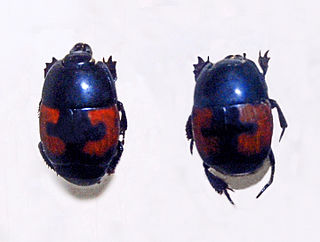
Hister is a genus of clown beetles in the family Histeridae. There are at least 210 described species in Hister.
Haeterius brunneipennis is a species in the family Histeridae, in the order Coleoptera ("beetles"). It is found in North America.
Dinocoryna arizonensis is a species in the family Staphylinidae, in the order Coleoptera ("beetles"). It is found in North America. It is a known associate of Neivamyrmex ants.

Haeterius is a genus of clown beetles in the family Histeridae. There are at least 20 described species in Haeterius.
Spilodiscus flohri is a species of clown beetles in the family Histeridae. It is found in Central America and North America.

Histerini is a tribe of clown beetles in the family Histeridae. There are at least 540 described species in Histerini.
Spilodiscus is a genus of clown beetles in the family Histeridae. There are about 9 described species in Spilodiscus.
Platylomalus aequalis is a species of clown beetles in the family Histeridae. It is found in North America.
Platylomalus is a genus of clown beetles in the family Histeridae. There are at least 60 described species in Platylomalus.
Paromalini is a tribe of clown beetles in the family Histeridae. There are at least 270 described species in Paromalini.
Xestipyge is a genus of clown beetles in the family Histeridae. There are at least 10 described species in Xestipyge.
Acritus komai is a species of clown beetles in the family Histeridae. It is found in Africa, Australia, Europe and Northern Asia, North America, Oceania, and Southern Asia.

Acritus is a genus of clown beetles in the family Histeridae. There are at least 110 described species in Acritus.

Acritini is a tribe of clown beetles in the family Histeridae. There are about 12 genera and at least 250 described species in Acritini.

Abraeinae is a subfamily of clown beetles in the family Histeridae. There are at least 20 genera and at least 440 described species in Abraeinae.
Geomysaprinus floridae is a species of clown beetle in the family Histeridae. It is found in North America.

Geomysaprinus is a genus of clown beetles in the family Histeridae. There are at least 20 described species in Geomysaprinus.
Platysoma gracile is a species of clown beetle in the family Histeridae. It is found in North America.
Carcinops viridicollis is a species of clown beetle in the family Histeridae. It is found in Central America and North America.
Hister civilis is a species of clown beetle in the family Histeridae. It is found in North America.




